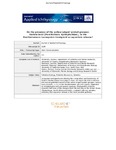Variola louti (Perciformes Epinephelidae) in the Mediterranean Sea: Incidental introduction or aquarium release?
| dc.contributor.author | Michailidis, N | |
| dc.contributor.author | Manitaras, I | |
| dc.contributor.author | Bernardi, G | |
| dc.contributor.author | Kleitou, Periklis | |
| dc.date.accessioned | 2020-01-19T16:53:08Z | |
| dc.date.available | 2020-01-19T16:53:08Z | |
| dc.date.issued | 2020-01-17 | |
| dc.identifier.issn | 0175-8659 | |
| dc.identifier.issn | 1439-0426 | |
| dc.identifier.other | jai.14001 | |
| dc.identifier.uri | http://hdl.handle.net/10026.1/15322 | |
| dc.description.abstract |
Introduction. Lessepsian immigrants (i.e. Red Sea species entering the Mediterranean through the Suez Canal) have greatly altered the composition and functioning of many Eastern Mediterranean shelf ecosystems and are expected to continue doing so, as new species arrive and establish self-sustaining populations in the region (Michailidis et al., 2019). Some of these species can potentially become invasive and through a series of mechanisms substantially change the community structure, cause the loss of native genotypes, modify habitats, affect food web properties and ecosystem processes, impede the provision of ecosystem services, impact human health, and cause substantial economic losses (Katsanevakis et al., 2014). Here, we report the first confirmed record of the yellow-edged lyretail grouper, Variola louti (Forsskål, 1775) in the Mediterranean Sea and Cyprus. Variola louti is an Indo-Pacific reef-associated grouper of commercial importance in its native range, and a popular species in the aquarium trade. It was first reported in Cyprus approximately a year ago based on an underwater observation, and its introduction was attributed to an aquarium release (Kousteni et al., 2019). In this report, the species was identified using both morphological characteristics and genetic analysis. The phylogenetic relationship with available sequences from specimens analysed in other regions was further examined and discussed. | |
| dc.format.extent | 231-234 | |
| dc.language | en | |
| dc.language.iso | en | |
| dc.publisher | Wiley | |
| dc.title | Variola louti (Perciformes Epinephelidae) in the Mediterranean Sea: Incidental introduction or aquarium release? | |
| dc.type | journal-article | |
| dc.type | Journal Article | |
| plymouth.author-url | https://www.webofscience.com/api/gateway?GWVersion=2&SrcApp=PARTNER_APP&SrcAuth=LinksAMR&KeyUT=WOS:000518957000013&DestLinkType=FullRecord&DestApp=ALL_WOS&UsrCustomerID=11bb513d99f797142bcfeffcc58ea008 | |
| plymouth.issue | 2 | |
| plymouth.volume | 36 | |
| plymouth.publication-status | Published | |
| plymouth.journal | Journal of Applied Ichthyology | |
| dc.identifier.doi | 10.1111/jai.14001 | |
| plymouth.organisational-group | /Plymouth | |
| plymouth.organisational-group | /Plymouth/Faculty of Science and Engineering | |
| plymouth.organisational-group | /Plymouth/Faculty of Science and Engineering/School of Biological and Marine Sciences | |
| plymouth.organisational-group | /Plymouth/Users by role | |
| plymouth.organisational-group | /Plymouth/Users by role/Academics | |
| dcterms.dateAccepted | 2020-01-07 | |
| dc.rights.embargodate | 2021-1-16 | |
| dc.identifier.eissn | 1439-0426 | |
| dc.rights.embargoperiod | Not known | |
| rioxxterms.versionofrecord | 10.1111/jai.14001 | |
| rioxxterms.licenseref.uri | http://www.rioxx.net/licenses/all-rights-reserved | |
| rioxxterms.licenseref.startdate | 2020-01-17 | |
| rioxxterms.type | Journal Article/Review | |
| atmire.cua.enabled |


